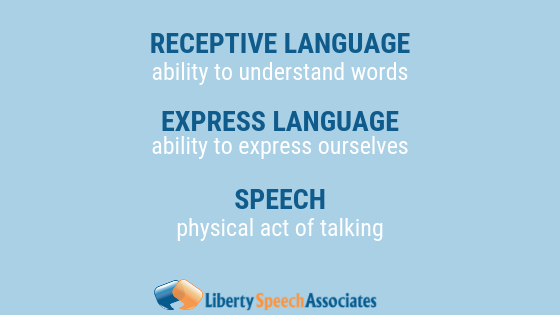The first 3 years of a child’s life are crucial to overall development. A lot of changes occur in just 3 short years. For example, a child begins walking, talking, and developing a unique personality. It can be an exciting time for families as they watch their children develop new and exciting skills. While it is an exciting time, it can also be scary if you don’t know what to expect. How do you know if your child is developing “normally” (especially if this is your first child)? I’m here to help you navigate through the first 3 years with this blog post about speech and language milestones.
Before discussing the milestones, I’d like to briefly explain the terminology used to describe communication. Understanding the differences between these terms is important in monitoring your child’s development.

There are two types of language: receptive and expressive. Receptive language is our ability to understand words. Receptive language is fundamental in the development of expressive language and speech. A child’s ability (or inability) to understand sounds and words will impact how s/he uses those words. Expressive language is our ability to express ourselves. Many people think that expressive language is synonymous with speech, but that, in fact, is not true. Expressive language is a broader term. It’s how we express ourselves in all modalities, whether it be speaking, writing, gesturing. Speech, however, is the physical act of talking; it is the way we make sounds.
So now that you understand the different aspects of speech and language, let’s see how your child is doing:
Before 6 months, a child typically:
Vocalizes and coos
Varies vocalizations based on needs
Begins babbling
By 1 year, a child typically:
Follows some simple directions
Identifies familiar objects
Enjoys Peek-a-Boo
Imitates sounds and words
Says a few words
Waves and uses gestures
Between the ages of 1 and 2, a child typically:
Points to objects/pictures upon request
Pays attention to books and pictures
Answers simple questions
Uses new words frequently
Begins combining words
Uses words instead of crying or gesturing
Says the b, d, p, m, n, and h sounds correctly
Is understood 50% of the time by age 2
Between the ages of 2 and 3, a child typically:
Follows two-step directions
Uses 2- and 3-word phrases and sentences
Tries to have a conversation
Is understood 75% of the time by age 3
Says the w, t, k, g, and f sounds correctly
Although these milestones are agreed upon by many in the field, it’s important to keep in mind that all children are different. Speech and language development can vary slightly from child to child. Therefore, it’s important to think about your child in comparison to other children in your family or in your community that are around the same age.
If your child is not following the pattern described above, or a pattern similar to those of the children in your family or community, your first step should be to have your child’s hearing tested by an audiologist. An audiologist is a hearing doctor and can complete a thorough examination of your child’s hearing ability (a pediatrician cannot perform this type of test). Hearing loss (even very mild hearing loss), as well as frequent ear infections or fluid in the ear, can impact a child’s speech and language development.
After you’ve had your child’s hearing tested, your next step should be to contact a speech-language pathologist to have your child’s speech and language skills evaluated.
References:
ASHA (n.d.). How does your child hear and talk? http://www.asha.org/public/speech/development/chart/
Coplan, J., & Gleason, J.R. (1988. Unclear speech: recognition and significance of unintelligible speech in preschool children. Pediatrics, 82,447-452.
McLeod, S. (2009). Speech sound acquisition. In J.E. Bernthal, N.W. Bankson & P. Flipsen Jnr (Eds.), Articulation and phonological disorders: Speech sound disorders in children (6th ed., pp. 63-120 + 385-405). Boston, MA: Pearson Education.

